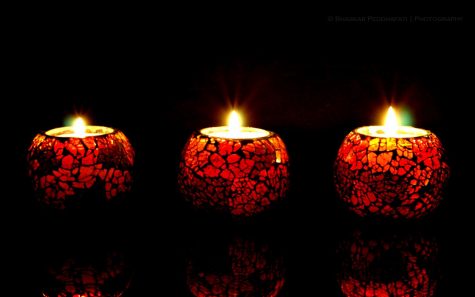Diwali – The Festival of Lights
November 7, 2017
For most Americans, October is the month to celebrate Halloween and November is reserved for Thanksgiving. However, for Hindus and other Indians around the world, this time of year is reserved for Diwali, the largest and most important festival in the country and the festival of lights. During this time, people exchange food, light diyas, or small lanterns, and meet with family and friends to celebrate.
Since the day Diwali is celebrated depends on the lunar calendar, rather than the solar calendar, the exact time it falls varies. In 2017, the holiday began on Thursday, October 19. However, it began on October 30 in 2016, and will begin on November 7 in 2018. Also, even though the holiday takes place over five days, the main festivities occur on the third day.
Considering India’s large population and varied culture, it’s no surprise that Diwali holds different meanings in different parts of the country. The main distinctions are between north and south India, but the main parts of Diwali are:
First Day: This day is called Dhanteras, and it is dedicated to wealth. People buy gold and gamble/play cards, but most importantly, they clean homes and get ready to welcome Lakshmi, the goddess of wealth and prosperity, into their homes.
Second Day: This day is called Naraka Chaturdasi in south India or Chhoti Diwali in north India. The god Krishna and the Goddess Kali are said to have defeated the demon Narakasura on this day, saving 16,000 captive princesses. People start setting off firecrackers on this day, create rangoli, or traditional art made with colored powder, and models of demons are burned in Goa to honor the defeat of Narakasura.
Third Day: This is the day of the new moon and is called Amavasya. It’s the most important day of Diwali, where firecrackers are set off across India and small lanterns, called diyas, and candles are lit. The Lakshmi Puja is performed to worship the goddess, and a Kali Puja is also done in some regions of India. Family and friends gather to exchange gifts and food, including mithai, which is a term for Indian desserts.
Fourth Day: This day has many different meanings across India. In Gujarat, it’s the start of the new year. In north India, Lord Krishna’s defeat of Indra, the god of thunder and lightning, is celebrated as Govardhan Puja. In the states of Maharashtra, Tamil Nadu, and Karnataka, Bali Pratipada or Bali Padyami celebrates the victory of Lord Vishnu over the demon king Bali.
Fifth Day: The final day of Diwali is called Bhai Duj, and it celebrates sisters. Siblings come together to eat food and celebrate their relationship.
This celebration is important to millions of people in India and around the world, and it has many different traditions in different places, all of which can’t be listed in this article. However, this is a small glimpse into the festival of Diwali.
Sources: https://www.tripsavvy.com/diwali-festival-in-india-guide-1539291
https://www.tripsavvy.com/when-is-diwali-1539426









